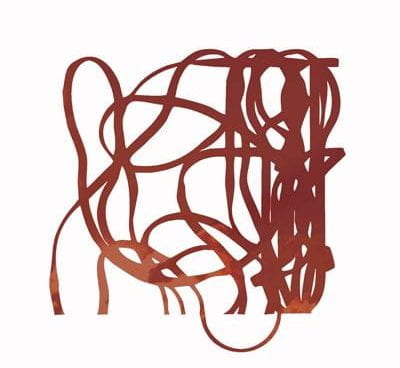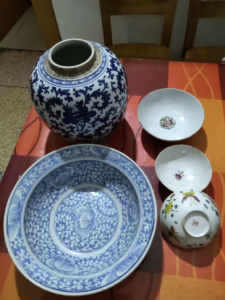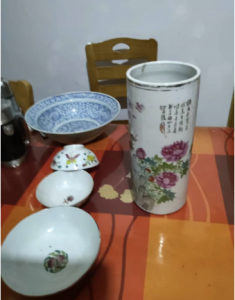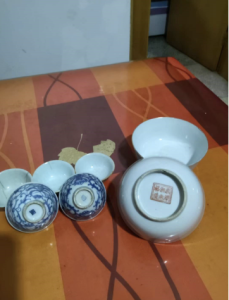Goldsmiths Confucius Institute recently took part in Come Dine in Blue, a participatory art project run by local New Cross gallery, hARTslane as part of We Are Lewisham, London Borough of Culture 2022.
Following on from this project, we met with members of the local and wider community in order to better understand the enduring cultural significance of blue-and-white porcelain and how this emblem of Chinese culture connects to personal and cultural identities.
These accounts from people all the way from Lewisham in London to Zhejiang in China reflect on the significance of blue-and-white porcelain and how interconnected and independent experiences of blue-and-white ceramics have helped to shape its history and place in our lives, traditions and the world today.
Please note these excerpts have been translated from Chinese to English
Mealtime Porcelain
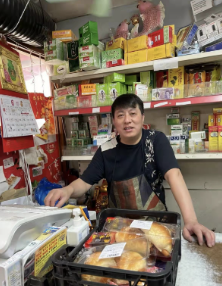
Account from Youzhu Guo, from Fujian province, current resident in Deptford, Lewisham; owner of Fu Qing Chinese Supermarket on Deptford High Street;
‘I come from a village in Fujian province, growing up we didn’t have any blue-and-white porcelain in our home, only [cheaper] plain white bowls.
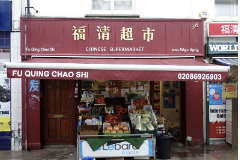
36 Deptford High Street, Deptford, Lewisham, London; Image credit: Mr. Wong
Nowadays young people are not interested in blue-and-white porcelain. I recently bought some pieces of blue and white porcelain from the shop opposite mine on Deptford High Street. It wasn’t a full set, but it was only a couple of pounds for each item; I use the porcelain now at mealtimes with my family.
I have lived here for more than 25 years now. [Why did I choose to buy the blue-and-white items?] Chinese people like Chinese things.’
Supermarket Porcelain
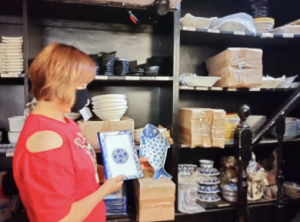
Account from Haiyan Zheng from Fujian province, current resident in Deptford, Lewisham; Owner of Ba Min Asian Catering Equipment Supermarket on New Cross Road
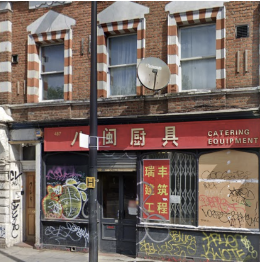
Supermarket, 487 New Cross Road, Deptford, Lewisham, London
‘I remember in my family home in China when I was younger, we had only blue-and-white crockery at mealtimes.
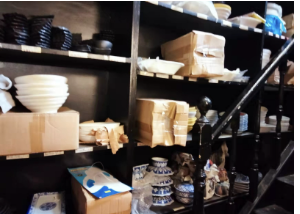
Nowadays young people are not interested in blue-and -white porcelain, they prefer crockery in brighter colours. I have had this shop since 2017 and I sell blue-and-white porcelain here. Chinese families don’t tend to buy this kind of crockery for their homes anymore though, it is usually only restauranteurs who come here to purchase it now.’
Fragmented Crockery, Fragmented Family
Account from Zhongwei Zhou (aged 29), from Sichuan province, current resident in the London borough of Southwark, Chinese Airline Branch Manager

‘I remember blue-and-white porcelain crockery from my grandmother and grandfather’s house; it wasn’t a particular set, just odd bits of crockery – some were rice bowls, some were larger pieces. I didn’t think of it as anything particularly special, it was just there, but I was also too young to think about any meaning that it might have had. As most people had little money during that time, the same crockery would be in the home for many years. I remember the same blue-and-white crockery being there for a long time without being changed or replaced by anything newer.
The reason it wasn’t a full set of crockery was probably because, in China, after you get married and leave the family home, parents would divide items from their house and split these up between their children. This departure is known as ‘splitting the family’ 《分家》(fēn jiā) in Chinese. My grandparents must have received these pieces from their parents once they started their new home.
Now I come to think of it, fēn jiā was also a reason why other siblings in older generations of my family fell out; some felt as though they had been treated unfairly in the process of fēn jiā, which led to rifts between siblings and between parents and children.’
My mother successfully hid her pregnancy of her second child (me) by spending most of the time hiding in her father’s pantry, so I have a sister, however, most families are one-child families nowadays. Fēn jiā rifts became less common among families after the one child policy was introduced.’
Family Heirloom Shapes Family Tradition
Account from Goldsmiths Confucius Institute Mandarin Teacher, Jihua Jia (aged 53), from Beijing, current resident in the London borough of Lewisham
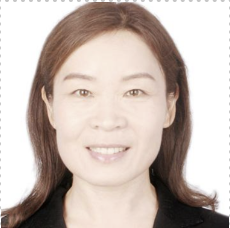
‘When I was little, we had a round blue-and-white porcelain plate in our family that had a circumference of approximately 30cm and dated back to the Qing dynasty; it was said to be a cherished family heirloom. Every year during Spring Festival gatherings the plate would be brought out and filled with freshly cooked dumplings.’
Kangxi Era Vase
Account from Chengxun Hu (aged 46), from Zhejiang Province, China, Primary School Teacher
‘This was originally a pair of vases made during the reign of Emperor Kangxi and passed on from my grandfather’s generation. This vase was given to my family during the process of fēn jiā (splitting the family) when my grandmother divided items from her home between my father and my uncle.
My family has always used it for flower arrangements, but once a gust of wind blew one of the vases onto the floor and it broke into pieces. Luckily, the other vase did not fall too. We did not want to throw away any of the fragments of the broken vase, so we bought a box and put them in it.’
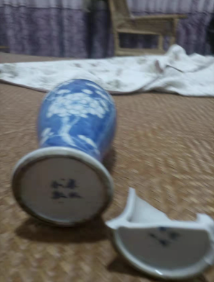
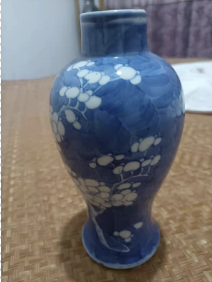
Afternoon Tea
Account from Chenjin Ying (aged 47), from Beijing, current resident of Deptford, Lewisham, Goldsmiths Confucius Institute Mandarin lecturer.
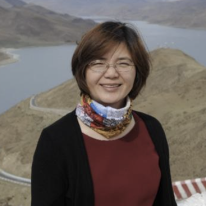
‘When I was younger, I didn’t appreciate blue-and-white porcelain, but now as I get older, I find I have come to value it more.
My favourite piece of blue-and-white porcelain is a blue-and-white teacup; it is from the Trimentea Gold Series. On weekend afternoons, I will often have tea and read a book, indulging in the peacefulness of a quiet and leisurely time.’
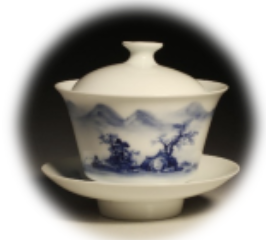
Photo credit: Taobao
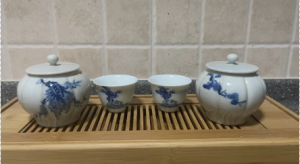
Hidden Treasures
Account from Daren Zhu (aged 80), from Sichuan Province, former primary school headmaster and Chenjin’s father-in-law
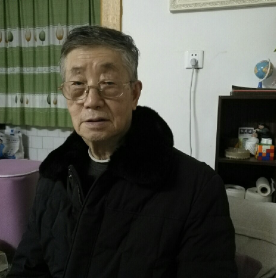
‘These porcelain pieces are all household items that my grandparents used prior to Liberation [establishment of the People’s Republic of China in 1949]. They were originally in pairs and sets, including drinking glasses and jugs. At the beginning of the Liberation, my father and uncle each took some for their own respective families in the process of fēn jiā (splitting the family). When I was a child, they were used for guests during Chinese New Year celebrations. I remember that later two large fish plates became broken. During the Cultural Revolution and the period of the Four Olds* they [these ceramics] were hidden away. These are the only ones that remain in our house today.’
* The Four Olds were: Old Ideas, Old Culture, Old Customs, and Old Habits
Daren Zhu’s remaining crockery pictured above.
Wedding Present
Account from Yulan Lyu (aged 49), former Lewisham resident from Beijing, University Lecturer
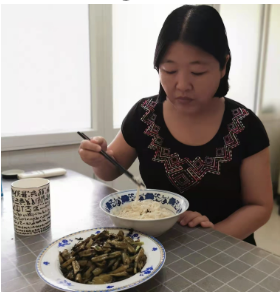
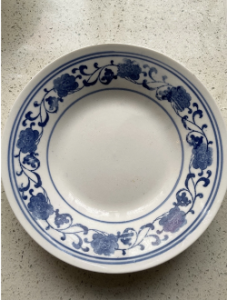
‘The image of the first plate is one that I bought when we first got married; we were renting at that time, and we had next to nothing in our home. One day I left the house and saw a lady in the street pushing a trolley selling blue -and-white porcelain. We kept on using this plate for many years and it proved quite hardy.
Later our financial situation improved; I remember one time when I was living abroad in Germany and I discovered that our landlord had many beautiful pieces of crockery in their home, I thought as a Chinese person I really needed to
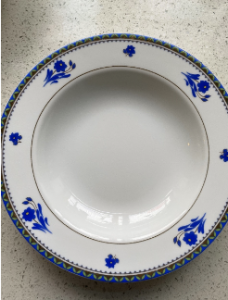
better myself in this respect. Our original plates looked quite cheap, so later I took a trip especially to a store in Beijing that sold Jingdezhen pottery and bought a whole new set of bowls and plates, they were all blue-and-white porcelain. I felt like I had gone up in the world, I even imagined that if I were from a privileged or aristocratic family that these would be plates that I use every day (smiling through tears!).
Still, we continue to use the first plate now. Even though in China we have a saying – new items are best, as are old acquaintances《物不如新,人不如旧》(Wù bùrú xīn, Rén bùrú jiù) – I feel like this plate is an exception because it was something that I bought for our home as a newlywed, and it still holds a lot of nostalgia for me.’
Broken Bowl, Broken Hope
Account from Tingting Fu (aged 47), from Zhejiang province, secondary school teacher
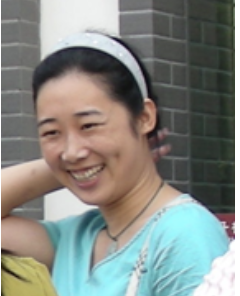
‘I only remember that the very last blue-and-white porcelain bowl in my house was broken by me. One evening, my mother was making me a bowl of soya sauce and lard fried rice as I waited by the stove. She finished frying it and handed it to me, but I hadn’t grasped it properly and it slipped and fell. My mother was so angry that she gave me a glance and said, butter fingers*!
And just like that, the last of our blue-and-white bowls was gone, the soya sauce and lard fried rice was gone and so too was my childhood…’
*《手指头没罗啊》(Shǒuzhǐ tou méi luó a) is a common saying in Yiwu City dialect in Zhejiang Province that can be translated as butter fingers. The saying literally means that if none of your ten fingertips have circular patterns on them then they will not hold things firmly and things will get easily broken.
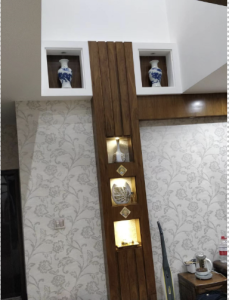 .
. 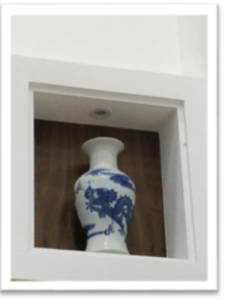
‘These are photos I took of two vases in my home. They are purely displayed for decorative purposes, I don’t have any story about them.’
A Young Ceramist
Account from Zheng Gao (aged 48), from Hangzhou in Zhejiang, Lecturer at Zhejiang Academy of Vocational Art
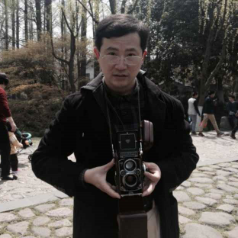
‘This teacup was made by Guanxi He, a 2016 graduate, majoring in Cultural Relic Identification and Restoration at Zhejiang Art Vocational College. Back then I taught him philology, book history and appreciation of famous instruments. He didn’t work very hard. After the first semester, he made an unsightly low quality Longquan teacup for his end-of-term coursework. I held him back at the end of class and said to him:
“There are still two and a half years left. I hope I can have a something [of quality] from you when you leave.”
This blue-and-white teacup was given to me when he graduated.’
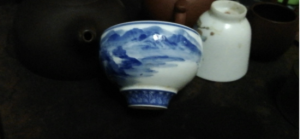
Items from my Home
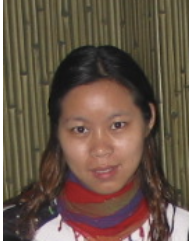 Account from Meijie He (aged 48), from Hangzhou in Zhejiang Province, Lecturer at China Academy of Art
Account from Meijie He (aged 48), from Hangzhou in Zhejiang Province, Lecturer at China Academy of Art
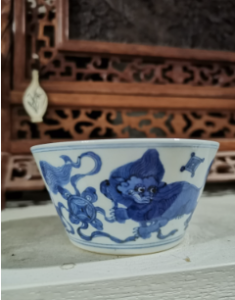
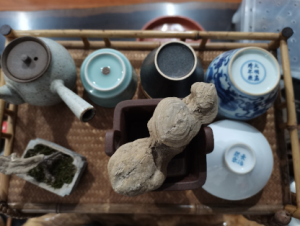
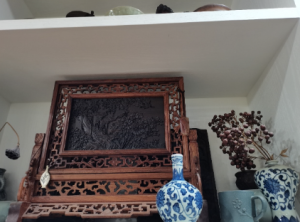
Above is collection of photographs of blue-and-white porcelain from around my home.
Items from my Home
Account from Xiangyang Li (aged 48), from Guangdong Province, Government Employee
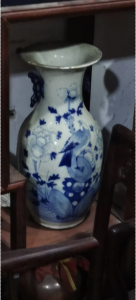 .
. 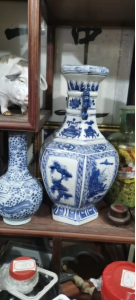
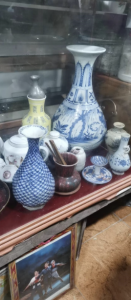
Above are pieces of Blue-and-white porcelain displayed in my home.
This project was undertaken by Chenjin Ying and Rachel Kanev on behalf of Goldsmiths Confucius Institute for Dance and Performance.
